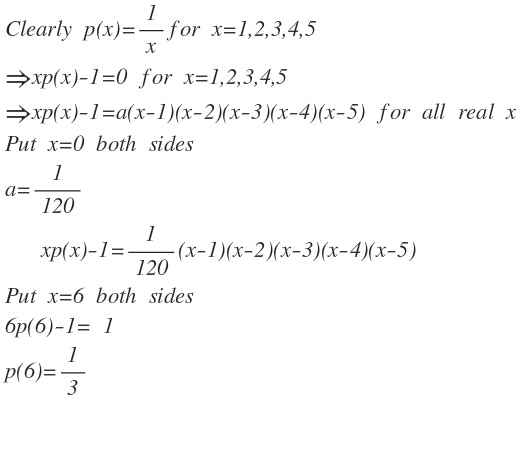Not sick of basick - 2
Let p ( x ) be a fourth degree polynomial such that p ( 1 ) = 1 , p ( 2 ) = 2 1 , p ( 3 ) = 3 1 , p ( 4 ) = 4 1 , p ( 5 ) = 5 1 and p ( 6 ) = B A .
Find A + B , where A and B are coprime.
The answer is 4.
This section requires Javascript.
You are seeing this because something didn't load right. We suggest you, (a) try
refreshing the page, (b) enabling javascript if it is disabled on your browser and,
finally, (c)
loading the
non-javascript version of this page
. We're sorry about the hassle.
3 solutions
Moderator note:
Great approach! That's the one that I'm thinking of, which is useful for solving such polynomials following a particular algebraic pattern.
Why is this a level 5 problem? Should be level 4. Regardless, concept employed is neat.
From the given information, we deduce that p ( x ) is of the form:
p ( x ) = 2 4 1 ( x − 2 ) ( x − 3 ) ( x − 4 ) ( x − 5 ) − 1 2 1 ( x − 1 ) ( x − 3 ) ( x − 4 ) ( x − 5 ) + 1 2 1 ( x − 1 ) ( x − 2 ) ( x − 4 ) ( x − 5 ) − 2 4 1 ( x − 1 ) ( x − 2 ) ( x − 3 ) ( x − 5 ) + 1 2 0 1 ( x − 1 ) ( x − 2 ) ( x − 3 ) ( x − 4 )
⇒ p ( 6 ) = 2 4 1 ( 4 ) ( 3 ) ( 2 ) ( 1 ) − 1 2 1 ( 5 ) ( 3 ) ( 2 ) ( 1 ) + 1 2 1 ( 5 ) ( 4 ) ( 2 ) ( 1 ) − 2 4 1 ( 5 ) ( 4 ) ( 3 ) ( 1 ) + 1 2 0 1 ( 5 ) ( 4 ) ( 3 ) ( 2 ) = 2 4 2 4 − 1 2 3 0 + 1 2 4 0 − 2 4 6 0 + 1 2 0 1 2 0 = 1 − 2 5 + 3 1 0 − 2 5 + 1 = 3 1
⇒ A + B = 1 + 3 = 4
Moderator note:
There is a much faster way using the Polynomial interpolation - Remainder-Factor Theorem .
Hint: What can we say about x f ( x ) ?
Crap. This was too much.
Sorry for my liberal use of words.
Just entered a random answer and got it correct :P
Wanted to see the solution.

We can generate an equation:
x p ( x ) = k ( x − 1 ) ( x − 2 ) ( x − 3 ) ( x − 4 ) ( x − 5 ) + 1 .
Sub in x = 0 we have:
0 = − 1 2 0 k + 1
So k = 1 2 0 1 and x p ( x ) = 1 2 0 ( x − 1 ) ( x − 2 ) ( x − 3 ) ( x − 4 ) ( x − 5 ) + 1 .
Sub in x = 6 we get:
6 p ( 6 ) = 1 2 0 5 ( 4 ) ( 3 ) ( 2 ) ( 1 ) + 1 = 1 + 1 = 2
p ( 6 ) = 6 2 = 3 1 .
So a + b = 1 + 3 = 4